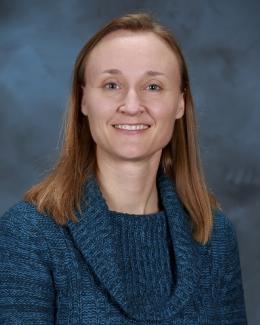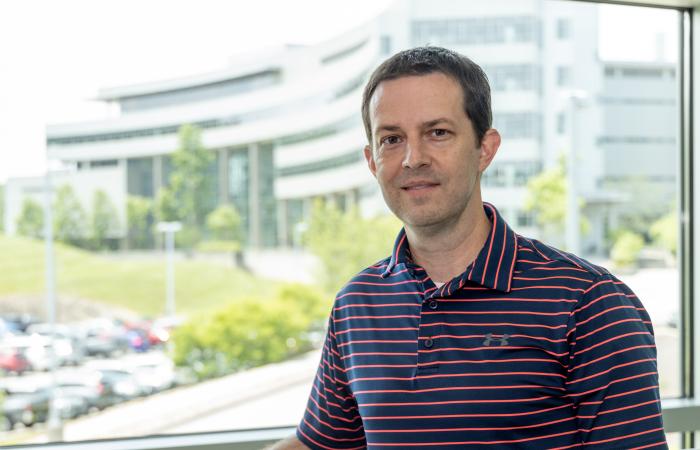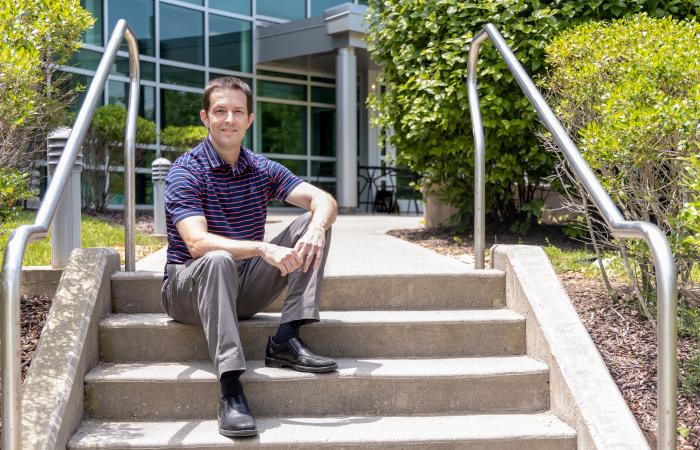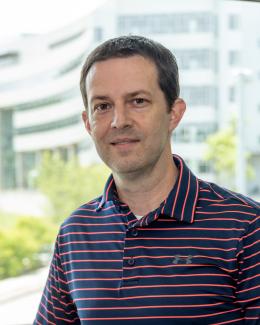When reading the novel Jurassic Park as a teenager, Jerry Parks found the passages about gene sequencing and supercomputers fascinating, but never imagined he might someday pursue such futuristic-sounding science. Fast-forward to today when Parks has achieved a broad range of real-life discoveries based on an understanding of the molecular processes that underpin everything from toxic methylmercury formation to viral infection in humans.
As lead for the Molecular Biophysics group at the Department of Energy’s Oak Ridge National Laboratory, Parks uses his expertise in computational chemistry and bioinformatics to unlock the inner workings of proteins, molecules that govern cellular structure and function and are essential to life.
Applying his expertise across science domains was one of the reasons he chose the versatile research environment at ORNL. “Large multidisciplinary projects are a nice way to get a lot of diverse scientists into a room on the same project, all working toward a common goal,” Parks said.
His first experience at ORNL was as a postdoctoral researcher working on a team exploring the origins of how inorganic mercury transforms into the potent neurotoxin methylmercury.
“I hardly knew anything about mercury, but I quickly started to learn about the microbiology involved, the genetics and genomics, the lab-based work, and even a bit of the field work,” Parks said. “I knew I needed to communicate without jargon about my research in a way that was understandable by people who did very different types of science.”
The result of that effort was the landmark discovery of the proteins responsible for bacterial mercury methylation. The scientists identified two genes, hgcA and hgcB, present in all known mercury-methylating bacteria and archaea and confirmed the work with genome editing. Parks was principal investigator for a follow-on project that created a 3D computational model of the protein complex to support additional research into mercury methylation.
A unifying theme across science domains
It was a quite different project that took Parks into the realm of antiviral drug discovery. Spurred by the COVID-19 pandemic, he led a multi-institutional team that designed a molecule to disrupt the infection mechanism of the SARS-CoV-2 coronavirus.
The molecule targeted a less-studied enzyme, PLpro, that helps the virus multiply and interferes with the host body’s immune response. Parks and colleagues used computational modeling to predict whether their designs would bind to and disrupt the enzyme. The team designed molecules to covalently bind PLpro by forming a strong chemical bond, in contrast to most drugs that bind noncovalently. They then synthesized the molecules and tested them to confirm their predictions.
“The drug discovery process can take many years and is very expensive. We wanted to kickstart the process by developing a new class of inhibitor that targets the virus in a different way from other drugs, and could potentially be used on new variants or a new type of coronavirus,” Parks said. “It’s good to have multiple weapons in your arsenal against viruses.”
Parks is also on a team of ORNL scientists designing enzymes to efficiently break down polymers in plastic waste. He’s making computational models of enzymes that have been identified as candidates for enhancement because of their natural ability to degrade nylon.
“So many important phenomena happen at the scale of proteins,” Parks said. “In this enzyme engineering project, for instance, we first need to know how these enzymes work and how they recognize nylon and break it down. Understanding the processes at the molecular level can help us design new approaches to deal with nylon pollution.
“Through most of my research, there’s the unifying theme of protein structure, function, mechanism and inhibition. The topics are different, but the techniques are often very similar, and I like being able to apply these methods to different fields.”
Communicating across disciplines is vital to the research, and something Parks said he’s worked to maintain and improve as he has taken on a panoply of projects. “I love to talk about science and communicate and learn what other people are doing at the lab. That’s how I can contribute, when I start understanding what everyone else is working on and how my skills can fit in and help out,” he said.
10,000 orchid plants and the next big thing
Growing up in Texas, Parks found he had a natural curiosity about how the world worked and developed an interest in science and technology. He learned about growing plants from a neighbor and parlayed those skills into a high school job overseeing three greenhouses full of 10,000 orchids owned by a private collector. Keeping the finicky plants alive in the Texas heat was no cakewalk.
After graduating high school he considered a career around another of his interests — playing guitar. “But after a while I decided I had no interest in being a rock star,” Parks said with a chuckle. He focused on science instead and said he chose to study chemistry because some of the most interesting molecules come from plants and natural products.
As a senior at Texas Christian University, Parks began hearing more about the burgeoning field of computational chemistry and decided to pursue the subject in graduate school. He earned a master’s at Southern Methodist University in chemistry with a focus on computational chemistry and went on to earn a doctorate in the same subject at Duke University.
Undecided about where to begin his professional career, Parks’ application for a postdoctoral position at ORNL was largely the result of a keyword search.
“My wife had lived in Knoxville previously, and she mentioned ORNL frequently. I thought it sounded like an interesting workplace — it’s not industry and not quite academia. But I didn’t think the lab did the kind of research I was interested in,” Parks said. “So I gave her a list of keywords, and one day I came in the door and she said, ‘What about this job?’” It was a postdoc position at the Center for Molecular Biophysics at ORNL under its director, Jeremy Smith. “I said ‘Yes, that’s a pretty good fit.’ So I applied and here I am, nearly 15 years later.”
A decade and a half into the job and having been promoted to group leader three years ago, Parks gives props to the lab’s culture. “ORNL’s environment, resources and people — that’s why I work here,” he said. “We have the facilities and resources, lots of talented scientists, and an overall environment that is conducive to impactful science, with the flexibility to work in different areas.”
Parks finds a lot of his motivation in problem-solving. “It could be a challenge in one of the areas I’ve already worked in, or an entirely new area. We’ll see what opportunities present themselves or which ones I find, because I’m always looking for the next big thing. I want to find problems that haven’t been solved and use my skills and the skills of the people around me to solve them. That’s a great feeling.”
Away from the lab, Parks still finds time for some of the hobbies he picked up along the way: growing orchids, working out and playing ultimate frisbee — a sport he cultivated in college. A sport of another kind comes in the form of parenting two kids. “We like playing games, and these days now that the evenings are longer, it’s a challenge to make sure their homework is done and they’re in bed at a reasonable hour.”
His advice for young people interested in a science career? “Be hungry for discovery,” Parks said. “You have to want to be a scientist, to be persistent in the process of not always getting it right the first time, then refining the work, iterating and improving. It takes persistence, patience and resilience. All of that is important.”
UT-Battelle manages ORNL for DOE’s Office of Science, the single largest supporter of basic research in the physical sciences in the United States. DOE’s Office of Science is working to address some of the most pressing challenges of our time. For more information, visit https://energy.gov/science.
— Stephanie Seay





